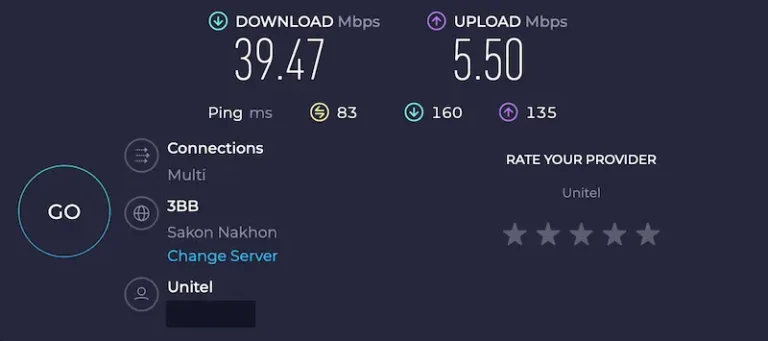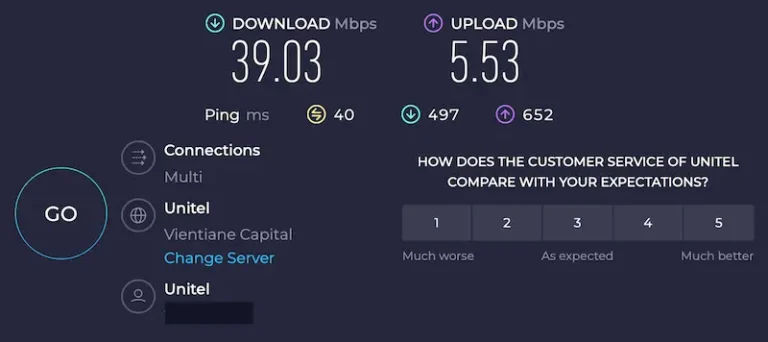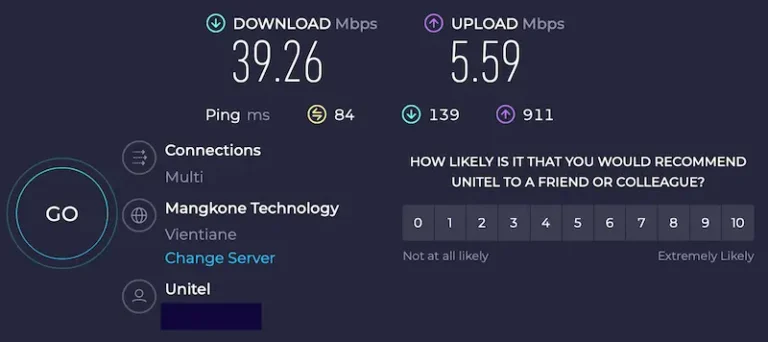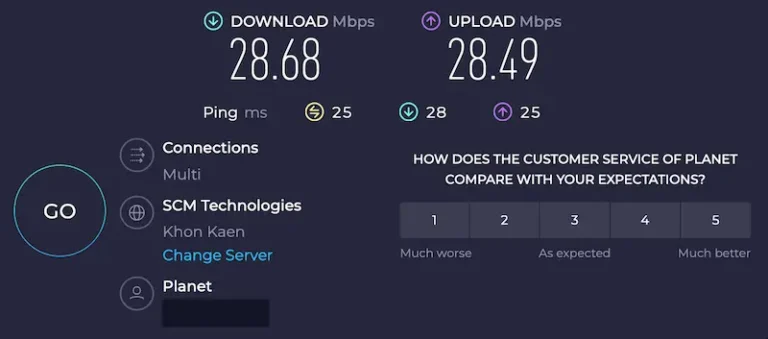
Disclosure: This article contains affiliate links. If you make a purchase through them, we may earn a small commission and you support our blog to write more helpful articles – at no extra cost to you.

As there is a growing number of people who are traveling and working remotely at the same time, it’s important to know about the reliability and connectivity of internet in a country. Working remotely in Laos as a Digital Nomad nowadays is no problem as infrastructure is developing fast. Beside the internet connection in Laos, I encourage everyone who is planning to visit the Lao PDR, to get familiar with general local customs, traditions and other important travel details by reading our extensive Laos Travel Guide. In this article I want to share my personal experience about internet speed in Laos as the owner of an online business & digital nomad myself.
Internet was officially Introduced in the late 90’s, but back then it was quite expensive and slowly like in many parts of the world. But from 2010 onwards, the internet throughout Laos was developing rapidly by introducing 3G and later followed by 4G from most of the internet providers in the country. A study from 2023 shows that 85% of the lao population are mobile phone users and 62% already have access to the internet, despite economical and infrastructural challenges within Laos. Locals use the internet mainly for Social Media networks like Facebook, Instagram or TikTok. Thanks the Development of better internet speeds, many young Laotians trying to build income streams with Social Media Platforms.
To reassure those who work online, it can be said that the internet in Laos is generally good. According to the global speed index, Laos has an average mobile speed of almost 50 Mbps and fixed broadband speed of around 40 Mbps. It is not as fast as in Thailand, which has one of the fastest internet speeds in the world and at the same time it is also not as bad as in the phillipines, where I experienced some of the worst internet in southeast asia. But there is to add, that internet Speeds in Laos are not always exactly the same, depending on different things. Here are some factors, which have an influence on Internet Speed:
The typical tourist in Laos, will probably stick around cities like Luang Prabang, Vientiane, Vang Vieng, Thakek, Savannakhet or Pakse anyway. In all of those mentioned areas, you will have absolutely no problem to have a good and stable internet connection with the biggest providers like Unitel or Lao Telecom. Almost all hotels and even smaller guesthouses nowadays have WiFi and if thats too slow, just use your smartphone for a mobile hotspot. Even in any other provincial cities like Phonsavan or Nong Khiaw.
The time of the day is something to consider when talking about how fast the Internet in Laos is. It can be said, that the internet is faster in the morning, mid-day, early afternoon and gets a bit slower late afternoon or evenings when many locals using social media or watching videos after a hard day of work. That being sad it doesnt mean that the internet gets unusable, but just a bit slower. I did a comparison of speed tests during different times of the day using my Unitel sim card as a mobile hotspot connected to my laptop and those were the results.

Internet speed test Unitel sim card as mobile hotspot in the morning. Internet speed as good as it gets in a bigger city (Savannakhet). Working and video calls are smooth. Just upload speed is a bit slow in general. Ping and latency are also alright during that time of the day. Source: speedtest.net

The speed test in the afternoon showed similar results like in the morning. It was done around 2 pm with the same sim card at the same spot. Ping got a bit better, while download and upload latency got a bit worse early afternoon. All in all not a significant difference. Source: speedtest.net

This speed test done on the same day just a bit after 7 pm, which is beginning of prime time for many people to heavily use social media, youtube, etc. Thats why the download speed dropped significantly and upload latency went up, which is another indicator for people streaming, watching videos, etc. Source: speedtest.net

The speed test done around 10 pm showed similar results. The download speed got faster again compared to the evening test, while the upload latency got a bit worse during that time. Uploading and streaming can be a bit slower at night, but is still feasible. Ping and download latency stayed about the same as a few hours earlier. Source: speedtest.net

This was tested in the evening with my home Wifi (company called Planet). Download is a bit slower than Unitel, but upload significantly better as well as ping and latency are better. So I prefer the home Wifi for video calls in the evening. Its likely that guesthouses have a similar landline provider. Source: speedtest.net
To understand the metrics of an internet speed test, let me give you a brief explanation about those numbers in general:
Download Speed (Mbps) – Measures how fast data is received from the internet. Higher speeds indicate faster browsing, streaming and downloads. Ideal Range: 10+ Mbps for basic use, 50+ Mbps for HD streaming, and 100+ Mbps for gaming or heavy downloads.
Upload Speed (Mbps) – Determines how fast data is sent from your device to the internet. Essential for video calls, cloud backups, and online gaming. Ideal Range: 5+ Mbps for video calls, 10+ Mbps for large file uploads, and 20+ Mbps for professional streaming.
Idle Latency = Ping (ms) – Measures the delay in communication between your device and the server when no data transfer is actively occurring. Can be described as time and indicates network responsiveness. Ideal Range: Below 50ms for smooth online experiences, under 20ms for gaming or VoIP.
Download Latency (ms) – The time delay experienced while receiving data. High download latency can cause buffering in streaming and slow webpage loading. Ideal Range: Below 100ms is good, under 50ms is ideal.
Upload Latency (ms) – Measures the delay in sending data. Affects live streaming, video calls, and gaming performance. Ideal Range: Below 100ms is acceptable, under 50ms is excellent.
I am working as a digital nomad since over 7 years now and experienced working from several different countries. My work consists of a mix of Webdesign, Online Marketing, editing of 3D & 360 tours, video calls with zoom and voice calls with WhatsApp. I usually dont have any troubles getting my work done during any time of the day. Just when working during peak hours between 6-9 pm, network and network response time can be a bit slower with a Unitel sim card or in general with any other sim card. For me that means longer loading times when using a Webdesign-Pagebuilder such as Elementor or sometimes smaller glitches during videos calls. But it was never that bad, that the video calls were not feasible, so still efficient during those 2-3 peak hours of the day. The rest of the day is always fine. I even worked from very remote rural villages in Laos, where the download speed even reached over 50 Mbps! But in rural villages internet may not be consistent and sometimes you will not even get a 4G connection. So better to do your work in towns or cities instead of small rural villages. But for most visitors to Laos, they will never get to those remote places anyway.
For me the internet connection, data packages and prices are much better compared to my home country Austria. I am from a small town in Austria and one of the richest countries in the middle of europe could still not figure out how to provide proper and affordable internet connection to every town. Even a third-world country like Laos is developing much faster than my home country, at least when it comes to providing internet to its citizen. Shame on you, Austria!
There are a handful of internet companies in Laos. In 2025 Unitel is the biggest provider and offers great coverage all around the country from northern Laos to the south. I have good experiences with Unitel since many years and even in very rural areas they sometimes have stronger signal than in urban parts of the country where there are a lot more users at the same time which uses up lots of bandwidth.
Second biggest provider is the state-owned Lao Telecom (LTC), which also works fine in major towns and some rural areas.
TPlus and ETL have more limited networks, primarily serving urban centers with less presence in rural regions. Therefore, for the most comprehensive coverage across Laos, Unitel stands out as the leading provider.
For most travelers going through Laos, Landline is probably not relevant. But the WiFi availability in a hotel or guesthouse is. Most of the accommodation now have a Wifi connection for their guests. Usually a connection which is also quite useful. But the same is true for Wifi: the more people use it, the slower it gets. For online workers and digital nomads in Laos it is therefore important to buy a sim card straight after arriving or an eSim before arriving as a backup if the hotel Wifi isn’t reliable.
Many digital nomads & remote workers overlook Laos when choosing their next spot to work remote from. Laos is still not as popular for digital nomads as mass touristic Thailand (luckily). Still, more and more people considering Laos as their next digital nomad base. The country getting more and more into the spotlight for online workers and thats for some reasons:
Why so many people talk about a VPN connection when traveling abroad and what exactly is it? Many people are promoting a VPN like NordVPN not only to earn affiliate commission, but for a good reason! A VPN (Virtual Private Network) simply encrypts your internet connection, hides your IP address and allows secure and private browsing by routing your traffic through a remote server.
When traveling you constantly log into different Wifi networks and sometimes they dont even have a secure password or password at all. By logging in to such unsecure networks, your data could be compromised. Especially when using banking apps, online wallets or other platforms where sensitive credentials are needed, I highly recommend using a VPN like NordVPN. Simple explanation of what a VPN is and how it can protect you in the video below.
Let me share a personal story: My debit card details got once somehow stolen and the thieves did plenty of smaller purchases of 10 $ each in the apple store and google play store. In particular I used mostly 2 different cards and they got both charged with many small amounts. So how did it happen? Well, believe it or not, at some point I didnt renew my VPN subscription yet and didn’t had it turned on. So its very likely that it happened using those cards abroad without turning on my VPN. Luckily my bank refunded me. But the gist of the story is: I will not browse sensitive website without a virtual private connection. As a digital nomad for over 7 years, it has been essential to me when traveling to any country, not just Laos.
In countries like Laos you might be even not able to browse some websites, because they are simply blocked (geo blocked IP address). Happened to me many times as well. For example when I want to use the online TV stream from Austria, there is no chance you can use it with a Lao IP address. So you actually have to use a VPN. And many more websites have geo blocking activated, which will block you from accessing their website from countries like Laos. I only recommend things I use myself. Thats why I like to share my positive experiences and advantages with NordVPN. Its also super cheap and they have a 30 days money back guarantee.
With an average download speed of around 30-40 Mbps and an upload speed between 5-28 Mbps, the internet speed in Laos is definitely good enough if you need to work online. Especially in urban areas you will find good internet infrastructure. Hotels and guesthouses provide useful Wifi connections and if thats not enough, get a sim card and use it as a hotspot. If you are traveling around a lot, especially further away from tourist spots and more remote areas, you can consider getting a second sim card as a backup. Get a Unitel sim or eSim as a primary card and a Lao Telecom sim card as a second one. Sim cards and data plans are very cheap in Laos. For 5-10 $ you can get over 50 GB of data for 30 days. But more on sim cards in our Laos sim card guide.